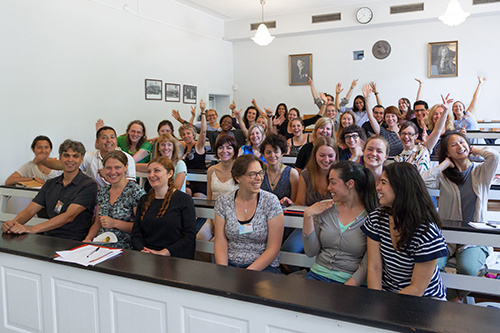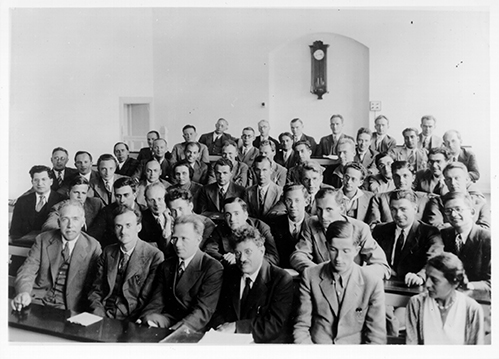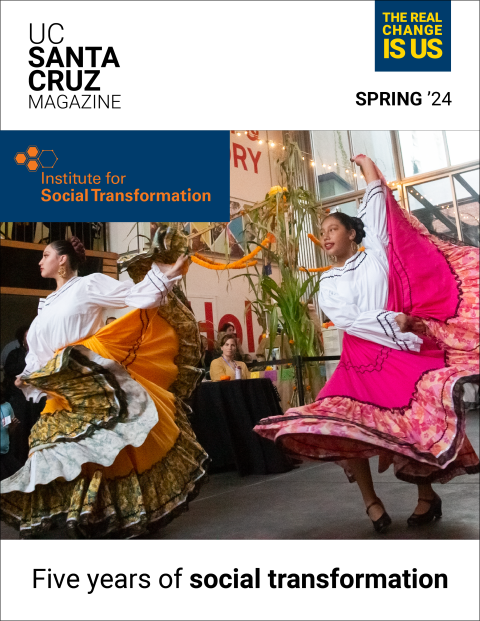Like them, the 37 astrophysicists in Ramirez-Ruiz’s photo came to Copenhagen to exchange ideas and advance our understanding of the universe. But unlike the scientists in the 1933 photo—which consists almost entirely of white men—Ramirez-Ruiz’s photo displays a group composed of almost all women, many of them women of color.
For Cyndi Atherton, director of the Heising-Simons Foundation science program, the photo illustrates the difference the foundation aims to make with an array of recent grants to UC Santa Cruz.
“What if a photo like that was not an anomaly? Imagine not thinking twice if you see a picture of scientists who are mostly women and underrepresented minorities,” Atherton says. “If a picture is worth 1,000 words, that’s my 1,000 words.”
A family foundation established in 2007, Heising-Simons supports climate solutions, fundamental science, education, and human rights organizations.
From July 2018 to January 2020, the foundation made grants totaling nearly $4 million to the campus.
Multiple of these support work by Ramirez-Ruiz, including an award that enabled the new Vera Rubin Chair for Diversity in Astronomy to earn matching funds from the UC Office of the President. Ramirez-Ruiz is the inaugural Vera Rubin chairholder.
The pipeline
When Ramirez-Ruiz was chair of the Astronomy and Astrophysics Department, he had an opportunity to hire a new faculty member to do computational astrophysics. Of the hundreds of applicants, less than a tenth were women. It’s a result of what he calls a pipeline problem: Women and underrepresented minority students don’t choose the sciences—in part because they don’t see faculty they can identify with.“So how do we change this?” he says, noting UC Santa Cruz can’t change what other universities do. “The only thing we can take charge of is our own department.”
Building a healthy pipeline involves making sure common challenges for first-generation students don’t become obstacles. Ramirez-Ruiz has focused recruitment, scholarships, fellowships on increasing the portion of women and minority undergraduates in the major. He provides undergraduates with opportunities to contribute to research.
The Lamat program, funded in part by the Heising-Simons foundation provides intensive astronomy training for community college transfer students.
The approach appears to be working: The portion of astronomy and astrophysics graduate students who are women or from underrepresented backgrounds is up to 50 percent.
“If you really want to increase diversity, you have to work at all levels,” Ramirez-Ruiz says. “Theoretically we could hire from our own grad students. Then we could make strides in solving the pipeline.”
Monica Gallegos-Garcia
In 10th grade, Monica Gallegos-Garcia saw a National Geographic video about Jupiter and realized there are people who have jobs studying the universe. At UC Santa Cruz, she majored in astrophysics, and in her second year she told her advisor she was interested in doing research.The conversation resulted in an introduction to Ramirez-Ruiz. Under his supervision, Gallegos-Garcia studied tidal disruption events, bright flares created when black holes tear apart stars.
“I got really great mentoring and advising and tons of support from him and from the larger network he put me in touch with,” Gallegos-Garcia says.
Gallegos-Garcia wrote a program to analytically describe the evolution of the flares. The work led to a paper on how the abundances of different chemicals in the flares change as the stars are consumed by the black holes.
The work she did with Ramirez-Ruiz helped her win a fellowship from the Ford Foundation, and now she’s working toward a Ph.D. at Northwestern University.
In the future, she sees herself in a faculty role where she, too, can help ambitious students pursue their goals in the sciences.
“I hope to one day become an Enrico myself,” Gallegos-Garcia says.
Rosa Wallace Everson
Support at UC Santa Cruz for diverse students seeking to become astronomers was part of what drew graduate student Rosa Wallace Everson. Everson studied physics at the University of Colorado. Deciding between graduate studies in particle physics and astronomy, she chose the latter in part because the field has been improving its inclusiveness.
“It’s nice to move into a field where I know there’s more of a chance I could make a difference,” she says. “Are my ideas about how to improve things socially accepted? At UC Santa Cruz, the answer was a resounding ‘yes.’”
At UC Santa Cruz, she researches what happens as older stars expand and engulf nearby objects like black holes or neutron stars. Heising-Simons’s support for the Vera Rubin Chair has created opportunities for her to attend international conferences with fellow astrophysicists. Her conversations at these events help hone her own work and establish professional connections.
“The network is definitely in full effect,” Everson says. “My hope is once my Ph.D. is over, these people will become my collaborators.”
Like Gallegos Garcia, Everson intends to pursue a faculty position where she can support women and underrepresented minority students.
Telescope builders of the future
In Berkeley last July, a group of researchers, instructors, and graduate and undergraduate students gathered to try out a workshop intended to expand the number of scientists, especially women, entering the field of astronomical instrumentation.Astronomers need astronomical instruments—sensors, spectrometers, filters, and other gadgets—to turn what comes through telescopes into images or data they can study.
Building instruments is a focus that can be discouraging to students. The requirement of both science and engineering gives the impression that a degree will take longer, and there are fewer opportunities to get work into publication. And it’s a field fewer women or minority students pursue.
Lisa Hunter, director of the UCSC Institute for Scientist and Engineer Educators, says the AstroTech summer School, which will hold its first session in summer 2020, will teach ways around these obstacles.
“The workshop will break some myths,” she says. “We show how to angle a project toward publication.”
The one-week workshop will focus on building instruments and on inclusion. In funding the workshop, the Heising-Simons included support for last July's “development” session.
Instructors tested methods to avoid teaching pitfalls that can become obstacles for underrepresented students. They tested curriculum focused both on tools and techniques of building instruments and practices that ensure inclusion.
“You can see the beginning of a community committed to promoting more diverse people entering instrumentation careers,” says Hunter. “It’s wonderful imagining instructors coming back year after year, gathering with other instructors and mentoring the next generation.”
Some recent Heising-Simons Foundation grants:
- AstroTech Summer School: training diverse new generations of astronomy instrument builders
- Vera Rubin Chair for Diversity in Astronomy: recruiting underrepresented minority and women astronomers and astrophysicists
- Advancing Theoretical Astrophysics Summer School: diversity-focused intensive training in theoretical astrophysics for graduate students
- Fellowships supporting transient astrophysics graduate students
- 51 Pegasi B fellowship: Post doctoral researcher Xinting Yu is building the science of the atmospheres of exoplanets
- Science Communication Program: enhancing instruction by experienced professionals and expanding fellowships for students in order to extend public understanding of science
- Other Worlds Laboratory: bringing graduate students and career scientists together to collaborate on the science of exoplanets—the latest round of funding includes a pool for mini-grants, enabling participants to expand on ideas generated during the conference
- Observing transient phenomena: Led by Professor Ryan Foley, the project will build instruments that continuously collect observations in order to capture short-duration events such as collisions between black holes
- SCALES—Santa Cruz Array of Lenslets for Exoplanet Spectroscopy: an instrument that will improve detection of exoplanets
- PEAS—Planet as Exoplanet Analog Spectrograph: an instrument that will collect observations of planets in the solar system as if they were exoplanets, giving astronomers models for data collected on exoplanets




